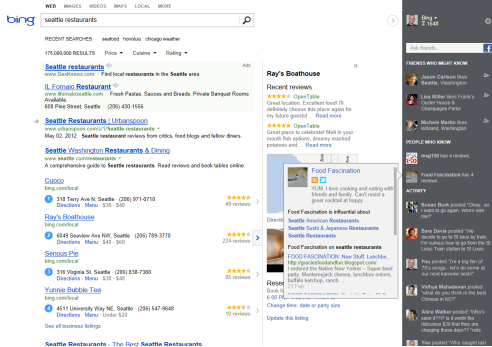Bing has announced a series of changes that take a major step in integrating search and social media. The company has revealed the roll out of a new social sidebar based on social data included in the search on the query. Internet marketers should note that Bing is working to integrate data from Facebook, Twitter and all of the leading networks into social results, which might give it an edge over Google. (The search giant successfully integrates Google+ data into SERPs, but Google+ activity lags considerably behind other platforms.)
The social sidebar is part of Bing’s new three-column SERP. Each of the columns contains different information related to a search query. In recent months, Bing has tested different designs and social strategies in an attempt to gain market share and appeal from Google and others using content marketing and SEO to improve visibility. While previous efforts have failed to resonate to this point, the new three-column SERP is the type of innovative, yet simple, strategy that could appeal to users.
The first column contains “core web results” to show users the search results they would typically see from Bing, though the company says these standard results have been improved. According to Bing, its frequent updates and adjustments to algorithms has increased results quality in a noticeable way for users.
A blog post explaining the new changes said that a blind test found 43 percent of respondents preferred Bing results to other engines, compared to 28 percent who said Google’s results were the highest quality.
Brafton recently reported that Bing has made some progress in the last year in terms of search market share but still trails Google considerably. Search data from April was not available at press time. However, March’s numbers from market research firm comScore pegged Bing’s market share at 15.3 percent. This pales in comparison to Google, which accounts for 66.4 percent of all queries. However, Bing has fielded 19 percent more searches in the last year.
The company hopes its three column search update will help it gain more ground.
While the first column provides “standard results,” the second column, dubbed Snapshot, contains information related to the tasks Bing users turn to the site for most frequently. Snapshot results include maps, contact information and other content likely to give users quick answers. Moreover, the paid search ads marketers purchase on Bing will now appear in this segment of the SERP.
These two columns represent a change in terms of layout, but no major shifts in the content presented. The third, however, is where things get interesting. On the right side of the page, users will notice a gray column that runs the height of the webpage and provides social results.

Shifting social integration to the right is part of Bing’s attempt to make it one with search without overwhelming the user. Google’s launch of Search, plus Your World in January frustrated some who believed the content was interfering with the actual search results in an attempt to boost traffic for Google+. By segregating social data, Bing gives users the option of finding recommended content or sticking to standard results.
The first social feature is the “Ask Friends” button, which allows users to post to their Facebook page via the Bing SERP. If search results don’t answer a query, the tool allows them to see if contacts can help. Below that, “Friends You Might Know” aggregates data from Facebook that is relevant to a query. The example Bing cites is a search for “Costa Rica,” which brings results that include content from the searcher’s Facebook friend who has posted photos or recent status updates relating to the nation.
“People You May Know” takes this a step further, aggregating data from Twitter, foursquare, Quora, LinkedIn, Google+ and Blogger. A query will produce results from random users who have shared related content. Finally, the Activity feed includes recent Bing activity from a user’s Facebook friends.
Bing’s three-column search changes have not been rolled out entirely. However, the updates will soon be available for all searches in the U.S., including those from mobile devices. For users concerned with privacy, data will only be included if it is available to searchers based on the privacy restrictions of each individual site social network.
Brafton recently highlighted a Bing SERP shift that essentially stripped all content other than search results. While many believed this move was aimed at making Bing simply about quality search results, the three-column approach launched on Thursday proves it was a step toward a much more advanced, yet clean, search experience for users.



